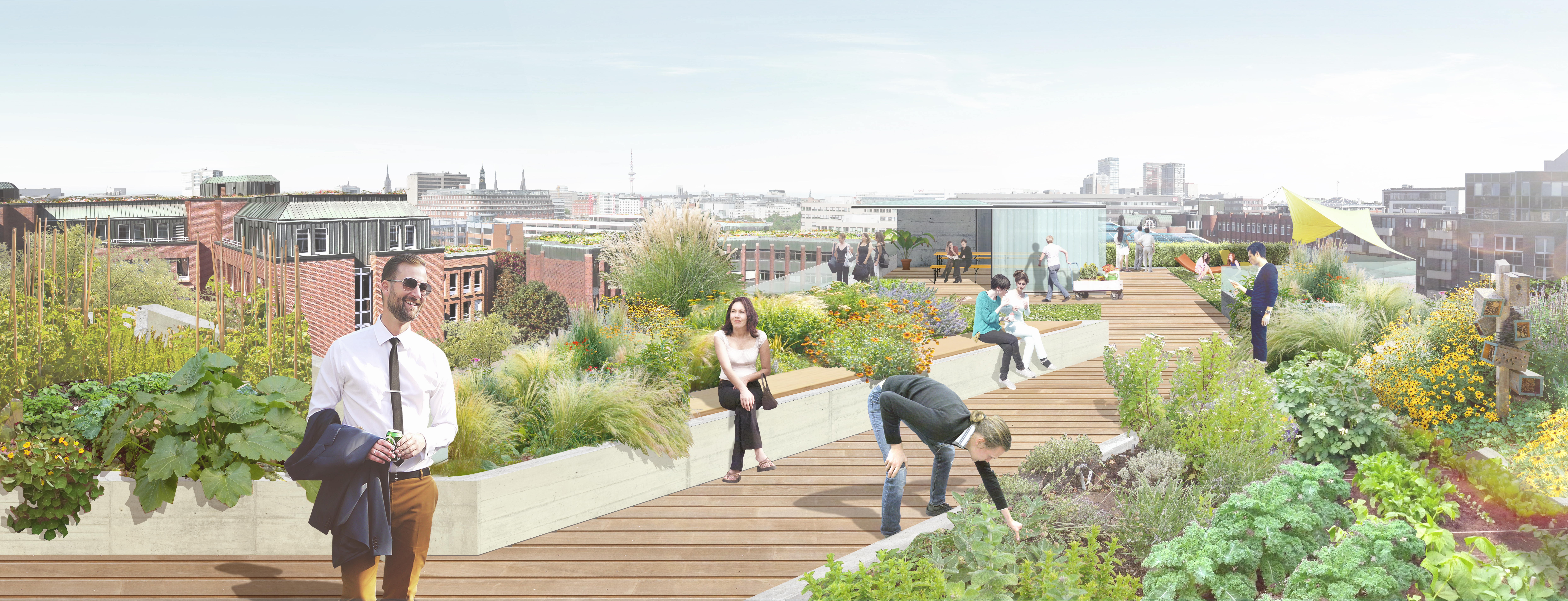This section provides information regarding the specific benefits and costs of green roof installations in Hamburg, as well as the financing set-up of the Green Roof Strategy and the corresponding incentive programme that is provided via the strategy. Green roofs are an investment with clear future returns. A green roof can create a more pleasant building climate and help to save on heating or cooling costs. It insulates in winter and cools in summer resulting in energy savings varying from 2-44% depending on roof insulation measures separate from the green roof. It also protects the roof water proofing from weathering effects so that green roofs last up to twice as long as conventional flat roofs. Plants and substrate on green roofs retain a large amount of rain water, which results in additional savings of 50% on rain water fees for the owner in Hamburg. In those instances where the water discharge does not require connection to the sewage system, fees can be eliminated completely.
When comparing roof types, estimated costs for installation, maintenance and replacement over a period of 40 years cumulate to € 20.500 for 300 square meters surface both for grey and green roofs. When focusing only on the initial installation, a green roof costs € 9.500 versus € 3.000 for a grey roof for 300 square meters surface. Green roofs have got a bit higher maintenance cost; in many cities 50% reduced rain water fees and a longer lifetime of the roofing explaining the same overall costs over a period of 40 years.
Hamburg’s Ministry for Environment and Energy invests ca. € 500,000 of its own resources for the implementation of the overall Green Roof Strategy, including efforts in all four areas of activity: promotion/support, dialogue and communication, scientific support, and policy/regulation. It also includes a full-time employee based at the Ministry.
In addition, Hamburg’s Ministry for Environment and Energy and the Harbour City University receive € 300,000 in federal grants on expenditure basis from the German Ministry of the Environment under a funding programme supporting local activities for the adaptation to climate change. This federal grant on an expenditure basis is used to pay a full time communications officer and a part-time HafenCity researcher for 2-3 years.
The Green Roof Strategy’s incentive programme has € 3 million at its disposal until the end of 2019. This amount includes the total remuneration to be provided under the financial incentive programme implemented via Hamburg’s investment and development bank (IFB), which handles all applications and transactions for the Green Roof incentives programme. Of the total € 3 million, € 2 million are sourced from the ‘implementation and service’ budget line of the Ministry responsible for city development and environment; the other € 1 million stems from the innovation fund of the Senate Office. The general approach taken is that financial incentives are available to those that voluntarily decide for a green roof before 2020. After that date Hamburg plans to have green roofs are compulsory by law. In particular, until 2020 building owners can receive subsidies to cover up to 30-60% of construction costs for the greening of their roofs.
The multi-functionality of green roofs is reflected in the subsidy system supporting the Green Roof Strategy. A basic subsidy creates incentives to build a basic green roof while additional funding encourages more specialized, sustainable measures. Optional additional subsidies are then provided for: constructing high quality rooftops (root penetration protection and improving load bearing capacity for existing roofs), sustainable urban develop (inner city roofs, a green roof in combination with solar energy generation, and/or space utilization area) and an extra flood prevention by reducing rainwater discharge (improving run-off delay). The following minimum standard criteria must be fulfilled before a green roof can be eligible for a subsidy under the Green Roof Strategy:
- Minimum 20 square meters net vegetation area and a maximum 30° roof pitch.
- Minimum 8 cm substrate soil thickness on new and existing commercial and garage buildings or existing residential and office buildings.
- Minimum 12 cm substrate soil thickness on all new residential and office buildings.
- Public buildings owned by the city itself are not eligible for the subsidy.
- Owners who voluntary decide for a green roof, and when it is not part of a binding green roof regulation.
The basic financial incentive then depends on the type of owner and size of the green roof:
- Private owners with a 20 -100 square meters green roof who live themselves in the building receive a 40% subsidy on the total construction cost, including materials and contractor, and even up to 60% on material cost if the constructors are trained (professionals) either in architecture, roofing, landscaping or gardening thus ensuring high quality in construction.
- For all other owners with a >20 square meters green roof - commercial, private, public - an owner receives a basic financial incentive ranging from € 14/square meters (on 8 cm substrate soil thickness) to € 56/ square meters (on 50 cm substrate soil thickness) net vegetation area (maximum can be achieved via additional subsidy of € 1/ square meters of net vegetation area per additional centimetre substrate soil thickness (rooting layer thickness)).



